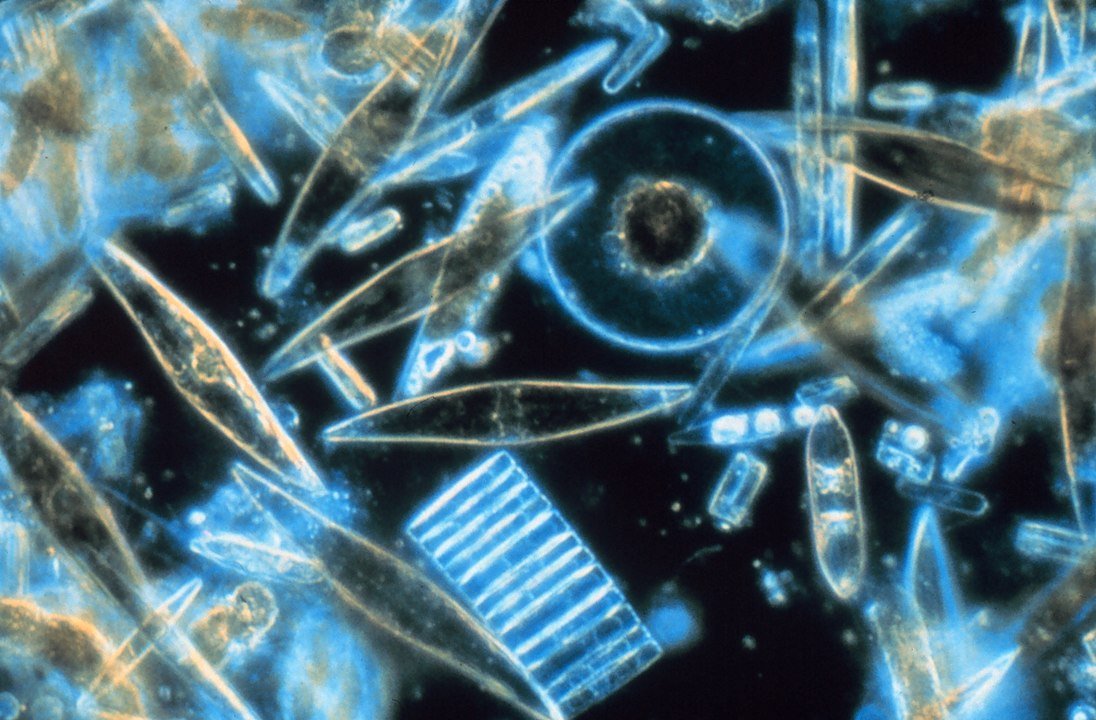Phytoplankton needs nutrients, carbon dioxide, and sunlight to flourish. Deforestation, the burning of fossil fuels, and other human activities have all contributed to severe climate change, impacting Phytoplankton productivity and functionality. The rate of Phytoplankton in our marine ecosystem decreases due to rising temperatures, which will result in less oxygen being available to us. Eventually, it contributed to an increase in global warming as a whole.
Let’s first discover what Phytoplanktons are and their influential role in various ecosystems of planet Earth.
Phytoplankton is microscopic organisms that live in both freshwater and saltwater. The term “Phytoplankton” is derived from the Greek terms “Phyto” (plant) and “plankton” (sea creatures) (made to float or drift). There are numerous phytoplankton species, which include bacteria, protists, and single-celled plants. Green algae, dinoflagellates, cyanobacteria, and coccolithophores are only a few more frequent kinds (coccolithophores with a chalk coating).
Phytoplankton, like terrestrial plants, converts photographic energy to chemical energy via chlorophyll. They breathe in carbon dioxide and exhale oxygen. All Phytoplankton species obtain energy primarily by photosynthesis; however, some consume from other organisms such as bacteria and algae. Numerous factors influence the growth of ocean Phytoplankton, including carbon dioxide, sunlight, and nutrient availability.
Phytoplankton species require varying amounts of calcium, nitrate, phosphate, and silicate, much as terrestrial plants do. Certain Phytoplankton species can bloom in the presence of low nitrate concentrations in the water. Plant development is impeded in many locations due to low iron concentrations in the water. Growth rates of Phytoplankton are regulated by a range of factors, including water temperature and salinity, water depth, wind, and the types of predators that graze on Phytoplankton.
Diatoms and dinoflagellates are major phytoplankton groups. On top of all that, they absorb CO2 from the surface of water and use it for photosynthesis via carbon cycling. They absorb carbon dioxide from the atmosphere and exhale oxygen back into it, providing us half of the oxygen we take daily. Phytoplankton is vital to marine life because they form the foundation of the food chain and web. Phytoplankton is the primary food source for most oceanic creatures—for example, larval fish feed on Phytoplankton, which is found in the water.

Phytoplankton diatoms have silica shells and are a type of diatom. Their bodies are buried in the ocean floor, where they decompose to make it healthy. Phytoplankton provides numerous advantages to marine life. As a result, these microscopic organisms play a critical role in the survival of marine life and, ultimately, in the survival of life on Earth. As the American oceanographer and marine biologist Sylvia A. Earle said:
“Even if you never have the chance to see or touch the ocean, the ocean touches you with every breath you take, every drop of water you drink, every bite you consume. Everyone everywhere is inextricably connected to and utterly dependent upon the existence of the sea.”
Phytoplankton and their types
Phytoplankton is a diverse group of organisms. Protists, which comprise complex eukaryotic cells such as protozoans, are classed as single-celled algae. Along with diatoms, several different species can be found along beaches. The population of this species can grow at an alarming rate in reaction to seasonal changes and the availability of nutrients such as nitrogen, iron, and phosphorus in the environment. Photosynthetic bacteria are a more primitive and abundant type of phytoplankton cell than algae, and they are a more primitive type of phytoplankton cell than algae.
Despite their diminutive size, each tablespoon of ocean water contains hundreds of thousands of these microscopic cells. Due to their minuscule size and inability to be caught in nets, these organisms were virtually unnoticeable until the 1970s. Apart from being the most abundant animal in the sea, these bacteria account for half of the ocean’s primary productivity. There are various species of cyanobacteria, which are considered among the earliest organisms on the planet and are responsible for the chloroplasts found in plant cells.
Importance to the Marine Ecosystem
Phytoplankton is essential for the survival of marine environments. The majority of marine food webs are based on autotrophs, or producers, rather than consumers. Their ability to store chemical energy in the form of sugars is since they are photosynthetic animals, which means they can convert solar energy to chemical energy. Other microscopic organisms, like Zooplankton, consume Phytoplankton as a food source. A growing number of different microorganisms are consumed by both Omnivores and Carnivores, which results in increasingly complex trophic connections between them and other creatures.
Aquatic creatures rely on autotrophic Phytoplankton as their principal source of nutrition, accounting for more than 98 percent of their total caloric expenditure. Phytoplankton is the building block of many aquatic food webs, including those that support plankton. They provide a diverse range of sea animals with nutritious food in a safe environment. For Phytoplankton (also known as microalgae) to survive and thrive, sunlight is required. This is similar to the situation with terrestrial plants.
Loss of Phytoplankton for marine food chains.
When the marine habitat is depleted and on the verge of extinction, several alternative scenarios are possible. As a result of various factors, the oxygen concentration in water declines to the point where aquatic life cannot exist. As a result, the water may become contaminated by contaminants from the surrounding environment, such as pollution from the ocean or air. As a result of such destruction, the majority of plants and animals become extinct. If animals perceive a hostile aspect in their natural environment, they are likely to be driven to relocate.

Affected residents living close to this body of water may be unable to benefit from the aquatic flora and animals that thrive there. There is a relationship between terrestrial and marine life, and the depletion of the latter will influence the former. This circumstance is noteworthy since octopus, starfish, salmon, and various other saltwater Species give substantial nutritional benefits to humans. Without a doubt, people will suffer as a result of the ozone layer’s loss.
Seals and other aquatic creatures are a food source for several marine animals, including whales, sharks, and a variety of other sea creatures. When one species dies, the entire food chain perishes with it. Coastal habitats are being lost or degraded, resulting in animal deaths and migration. Certain plants fail and eventually become extinct as a result of harsh environmental conditions. When water bodies are lost or degraded due to marine habitat degradation and loss, the rate of land conversion accelerates rapidly. While this may aid human settlement, additional benefits associated with aquatic life are almost guaranteed to be lost as a result.
What future holds for Phytoplankton?
As one creature relies on another for nutrients and so on, the food chain is interrelated. Shrimp populations will suffer if plankton levels in the water decrease and salmon populations suffer from food scarcity. The Phytoplankton population’s health affects the global climate’s health. Phytoplankton photosynthesis accounts for almost half of all photosynthesis on the globe. They are the primary scavengers of carbon dioxide in our atmosphere, extracting the gas and replacing it with oxygen. Winding up, Phytoplankton is a tremendous overlooked asset to the ecosystem.
References
Bullock, H. A., Luo, H., & Whitman, W. B. (2017). Evolution of dimethylsulfoniopropionate metabolism in marine Phytoplankton and bacteria. Frontiers in Microbiology, 8, 637.
Yang, L., Li, H., Zhang, Y., & Jiao, N. (2019). Environmental risk assessment of triazine herbicides in the Bohai Sea and the Yellow Sea and their toxicity to Phytoplankton at environmental concentrations. Environment international, 133, 105175.
Zhongming, Z., Linong, L., Wangqiang, Z., & Wei, L. (2018). Later tropical blooms could affect marine life.
Naselli-Flores, L., Zohary, T., & Padisák, J. (2021). Life in suspension and its impact on phytoplankton morphology: an homage to Colin S. Reynolds. Hydrobiologia, 848(1), 7-30.
Jorda, G., Marbà, N., Bennett, S., Santana-Garcon, J., Agusti, S., & Duarte, C. M. (2020). Ocean warming compresses the three-dimensional habitat of marine life. Nature Ecology & Evolution, 4(1), 109-114.
Also, Read: The Faults in our Food Foibles: A Guide to Eating Better

Samra Hayat Khan is a Biotechnologist, currently works in a pharmaceutical company as a research and development officer. Samra is a passionate advocate for marine sciences, their unparalleled benefits for humankind, and their significance for saving mother earth.

